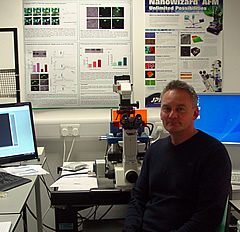JPK Instruments, a world-leading manufacturer of nanoanalytic instrumentation for research in life sciences and soft matter, reports on the study of the research work of Dr Paul Squires and his colleagues at the University of Warwick.
 Dr Paul Squires from the University of Warwick with his JPK CellHesion®200 system
Dr Paul Squires from the University of Warwick with his JPK CellHesion®200 system
Dr Paul Squires and Dr Claire Hills from the School of Life Sciences (SLS) at the University of Warwick have international expertise in cell biology, signalling and endocrinology. They are using the JPK CellHesion® 200 system (funded by Diabetes UK) to nurture multi-disciplinary research between SLS and the School of Engineering (Dr K-K Liu) in addition to external collaborations, e.g. Professor Peter Jones (King’s College London). The innovative nanotechnology is being used to explore a range of problems in biomedicine, biology and pharmacokinetics related to the field of energy homeostasis and diabetes, and the state-of-the-art resource facilitates their experimental work on models of the disease, bridging the gap between basic science, nanotechnology and medicine for developing the next-generation of therapies.
Cell-cell adhesion has been studied using fluorescence microscopy, capillary techniques or mechanical methods such as rotation assays and flow chambers. However, all of these techniques have limitations. Either they provide qualitative results that are difficult to interpret or are complicated to operate. The CellHesion® 200 is an integrated system designed to measure cell-cell and cell-substrate interactions. Epithelial tubular cells of the kidney are large and have an elastic membrane. To resolve complete separation of two adherent cells we require a system with a pulling length of up to 100 μm. Other AFM instruments cannot offer this level of manoeuvrability and are unable to record full separation of large cells. The CellHesion® 200 system can also be used to quantify membrane rigidity and cellular responses to external mechanical stress. This facilitates investigations into glucose-evoked changes in TRPV4-mediated mechano-sensation in the renal collecting duct.
The group have published several papers relating to diabetes research where the CellHesion system has been integral to their investigations. These include papers* in the journals of Experimental Diabetes Research, Diabetologia, Febs Lettersand Cell Physiology & Biochemistry. Most recently, the group has reported results on the study of the effects of the “party drug” ketamine and its effect on renal and bladder behaviour were CellHesion is being used to assess if early changes in candidate protein expression at the adherens junction functionally uncouple cells ahead of overt loss in epithelial function (in PLoS one, funded by the Rosetrees Trust).
Commenting about the use of the CellHesion® 200, Dr Squires said “To resolve complete separation of two adherent cells we require a system with a pulling length of up to 100 μm. The CellHesion system is the only AFM-based instrument on the market capable of allowing this degree of separation.”
For more details about JPK’s CellHesion® 200 system and applications for the bio & nano sciences, please contact JPK on +49 30533112070, visit the web site: http://www.jpk.com/ or see more on Facebook: www.jpk.com/facebook and on You Tube: https://www.youtube.com/jpkinstruments.